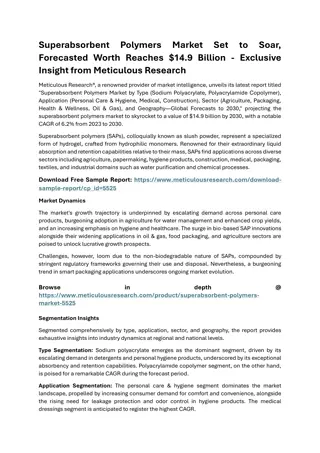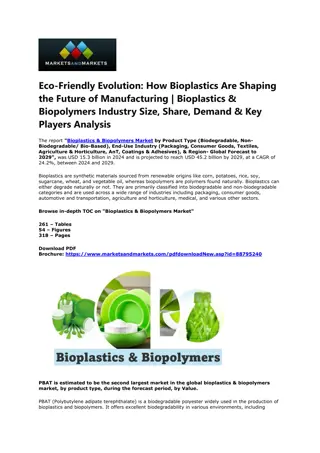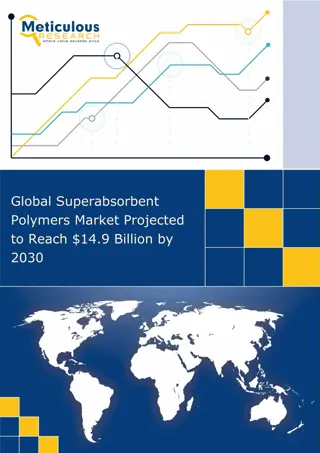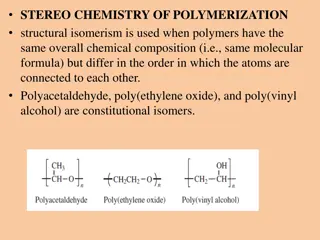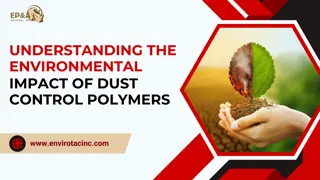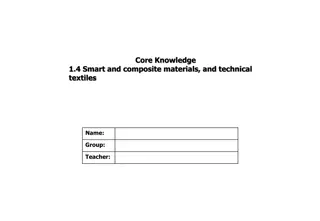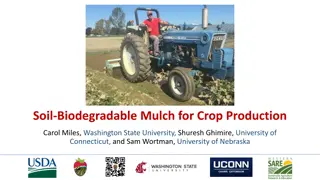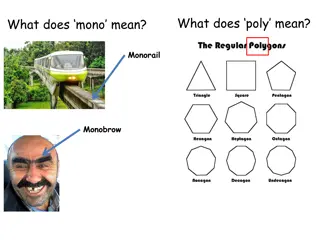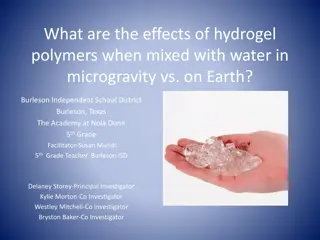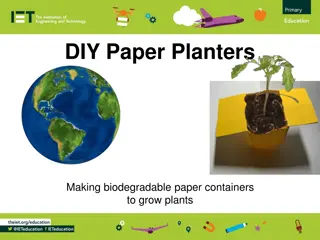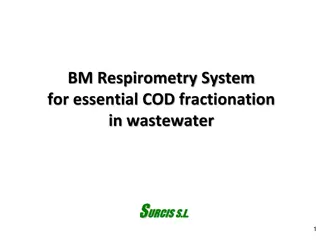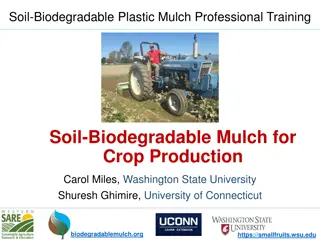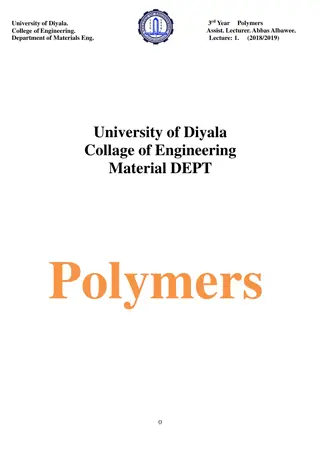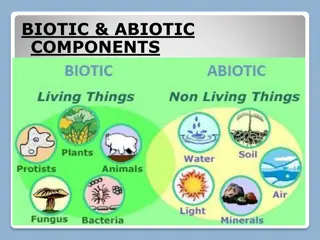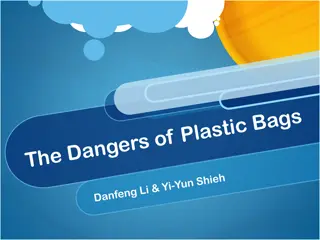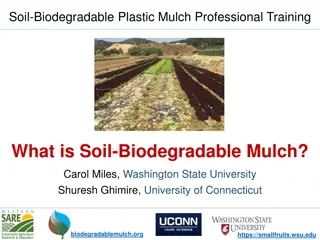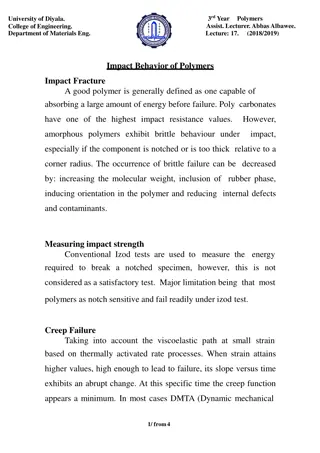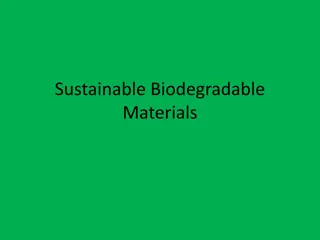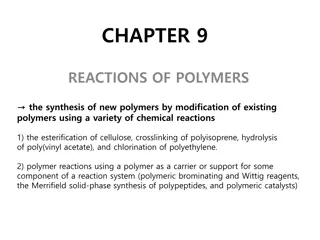Understanding Polymers: Classification and Properties
Polymers are large molecules formed by joining many monomers together. The process, known as polymerization, creates long chains with unique structures. This article explores different classifications of polymers based on origin, monomers, thermal response, formation mode, structure, application, ph
1 views • 13 slides
Exploring the Fascinating World of Hydrogels and Polymers
Dive into the realm of hydrogels and polymers, discovering their unique properties and versatile applications in everyday life and medicine. Learn how to create hydrogels using the chelation process and explore the science behind these water-loving materials. From contact lenses to knee surgery inno
0 views • 16 slides
Superabsorbent Polymers Market Set to Soar, Forecasted Worth Reaches $14.9 Billion
Superabsorbent Polymers Market by Type (Sodium Polyacrylate, Polyacrylamide Copolymer), Application (Personal Care & Hygiene, Medical, Construction), Sector (Agriculture, Packaging, Health & Wellness, Oil & Gas), and Geography - Global Forecast to 2030
0 views • 2 slides
Revolutionising Metal Pitting Repair for Your Vacuum Pumps
In industrial maintenance, the battle against metal pitting and other forms of mechanical damage is ongoing. Rezitech approaches this challenge by offering a groundbreaking solution using Belzona metallic polymers.\n\nThese high-performance solutions are specifically designed to repair and rebuild m
3 views • 5 slides
Biodegradable Diapers Market- Size, Share, Trends & Forecast 2032
The global biodegradable diapers market size was USD 3.7 Bn in 2022 and is likely to reach USD 7.2 Bn by 2031, expanding at a CAGR of 7% during 2023\u20132031.
0 views • 6 slides
The Chemistry of Coatings. Scientific Inquiry Project
Delve into the world of coatings and polymers through scientific inquiry projects, understanding the steps of the scientific method and engineering design. Learn about polymers, epoxies, and their various applications in coatings, adhesives, industrial tooling, electronics, and more.
0 views • 25 slides
Beyond Petroleum: Bioplastics as a Renewable Alternative
Bioplastics are synthetic materials sourced from renewable origins like corn, potatoes, rice, soy, sugarcane, wheat, and vegetable oil, whereas biopolymers are polymers found naturally. Bioplastics can either degrade naturally or not. They are primarily classified into biodegradable and non-biodegra
1 views • 3 slides
Vintech Polymers Private Limited Brochure
Vintech Polymers Pvt. Ltd. opened its doors in 2007 and have doubled its capacity every year. The reasons for this is Friendly Customer Service, Meticulous Procedures, and some of the Shortest Lead Times in the industry. These benefits combined with dyanamic Management Team with expertise in packagi
0 views • 13 slides
Superabsorbent Polymers Market
Meticulous Research\u00ae\u2014a leading global market research company, published a research report titled, \u2018Superabsorbent Polymers Market by Type (Sodium Polyacrylate, Polyacrylamide Copolymer), Application (Personal Care & Hygiene, Medical, Construction), Sector (Agriculture, Packaging, Hea
1 views • 4 slides
Vintech Polymers Private Limited - Leading Mineral Water Labels Manufacturer, PVC Heat Shrink, and Plastic Labels Supplier in India
Vintech Polymers Private Limited is a leader in the manufacture and supply of mineral water labels, PVC heat shrink labels, and plastic labels in India. Their commitment to quality, innovation, and customer satisfaction sets them apart in the industry. For businesses seeking reliable and high-qualit
0 views • 3 slides
Understanding Polymers and Their Properties
Polymers are long chains of repeating monomers, with both natural and synthetic varieties. Natural polymers include silk, cellulose, and DNA, while synthetic ones encompass plastics, fibers, and elastomers. The properties of polymers, such as molar mass and monomer structure, determine their functio
0 views • 15 slides
Understanding Oil-Water Interaction and Oil Absorbing Polymers
Explore the intricacies of why oil and water don't mix, the challenges faced in containing oil spills, and the innovative solution of oil-absorbing polymers like Enviro-Bond 403. Discover the science behind non-polar substances, hydrophobicity, and the role of polymers in environmental protection.
2 views • 7 slides
Stereochemistry and Isomerism in Polymerization
Structural isomerism plays a crucial role in polymer chemistry by distinguishing polymers with the same molecular formula but different atom connectivity. Isomeric polymers can stem from different monomers or polymerization routes, resulting in variations in properties. Stereoisomerism, on the other
1 views • 36 slides
Interpenetrating Network Polymers and Composite Materials in Modern Industry
Polymer mixtures or blends, known as Interpenetrating Network Polymers (IPNs), offer convenient routes for modifying properties to meet specific needs in modern industry. IPNs involve not covalently bonded polymers that can be mixed in various ways to create unique material properties. Additionally,
2 views • 13 slides
Understanding the Environmental Impact of Dust Control Polymers
Dust control polymers bind dust particles, reducing air pollution and water use while preventing soil erosion, offering an eco-friendly solution for various industries.\n
0 views • 1 slides
Understanding the Environmental Impact of Dust Control Polymers
Dust control polymers bind dust particles, reducing air pollution and water use while preventing soil erosion, offering an eco-friendly solution for various industries.\n
0 views • 10 slides
Understanding Thermal Properties of Materials
Materials respond differently to heat based on their thermal properties such as heat capacity, thermal expansion, conductivity, and shock resistance. The ability of materials to absorb heat, expand with temperature changes, and conduct heat varies across ceramics, metals, and polymers. Heat capacity
0 views • 19 slides
Understanding Additives in Plastics and Polymers - GCSE Design Technology Lesson
Explore the world of plastics and polymers in this GCSE Design Technology lesson as you delve into the different additives used to enhance their properties. Gain insights into the origin of plastics, their environmental impact, and various additives like fillers, flame retardants, plasticizers, and
0 views • 21 slides
Understanding Biodegradable and Non-Biodegradable Materials
Biodegradable items are made of natural materials that break down easily, contributing positively to the environment. Examples include paper, wood, and food scraps. On the other hand, non-biodegradable items, made of synthetic materials, do not break down easily and can be toxic, leading to pollutio
0 views • 6 slides
Thermodynamic Principles of Polymers in Solution: Flory-Huggins Theory and Macromolecular Solutions
Understanding the thermodynamic behavior of polymers in solution is crucial in various industrial and scientific applications. The Flory-Huggins theory provides insights into athermal macromolecular solutions, heat of mixtures, interaction parameters, and the concept of good vs. mediocre solvents. T
1 views • 77 slides
Understanding Polymers: Structure, Properties, and Design Considerations
Explore the world of polymers, from the basics of polymer structure and properties to the intricacies of copolymerisation and thermoplastics. Dive into the role of molecular structures in determining polymer properties and discover the diverse applications of elastomers, plastics, and fibres in our
0 views • 15 slides
Global Medical Polymers Market
\"The Global Medical Polymers Market is expected to reach USD 41.64 Billion by 2032, at a CAGR of 7.8% during the forecast period 2022 to 2032. \n\n\"\n
0 views • 5 slides
Exploring Smart and Composite Materials in Modern Technology
The content delves into the realm of smart and composite materials, highlighting modern advancements and applications such as shape-memory alloys, nanomaterials, photochromic glass, temperature-responsive polymers, and more. It discusses the advantages, disadvantages, and examples of composites like
0 views • 11 slides
Sustainable Mulching Practices for Enhanced Crop Production
Implementing soil-biodegradable mulch in crop production offers an eco-friendly alternative to traditional polyethylene mulch. Benefits include weed control, soil moisture retention, and temperature regulation, with comparable yields to polyethylene mulch. Certified biodegradable options are availab
0 views • 8 slides
Understanding Polymers: Monomers to Polymers
Explore the world of polymers by learning about monomers and polymers, how alkenes are used to create polymers, and the process of polymerisation. Dive into the structure of poly(ethene) and poly(propene) through diagrams and hands-on activities with molymod kits.
0 views • 19 slides
Economic Considerations for Soil-Biodegradable Plastic Mulch Adoption in Agriculture
Economic considerations play a crucial role in adopting new technologies like soil-biodegradable plastic mulch in agriculture. This training provides insights into the costs, benefits, and overall profitability of using biodegradable mulch compared to traditional practices. It covers aspects such as
1 views • 17 slides
Effects of Hydrogel Polymers in Microgravity vs. on Earth
This experiment aims to investigate how hydrogel polymers, specifically sodium polyacrylate, interact with water in microgravity compared to on Earth. The team from Burleson Independent School District in Texas is exploring whether the polymers absorb more or less water in a weightless environment.
0 views • 9 slides
DIY Biodegradable Paper Planters Guide
Create your own eco-friendly planters with this step-by-step guide using A4 paper. Follow the folding instructions to make biodegradable containers for growing plants, then add soil, seeds, and cover with cling film to kickstart your plant nursery.
0 views • 15 slides
Advanced Respirometry System for Wastewater COD Fractionation
Discover the BM Respirometry System offering three operation modes for essential COD fractionation in wastewater analysis. Learn about the main automatic parameters such as Oxygen Uptake Rate, Specific OUR, and Dynamic Respiration Rate. Explore essential COD fractions and their impact on wastewater
0 views • 25 slides
Exploring Soil-Biodegradable Plastic Mulch for Sustainable Crop Production
Discover the benefits of using soil-biodegradable plastic mulch as an alternative to traditional PE mulch in crop production. Learn about its environmental advantages, efficient removal methods, impact on yield and weed control, and compliance with USDA's organic program. Find insights on biodegrada
0 views • 9 slides
Understanding Polymers: Structure, Properties, and Terminology
Learn about polymers, their structure, and terminology in this introductory lecture by 3rd Year Assistant Lecturer Abbas Albawee at the University of Diyala. Explore the definition of polymers, their general properties, and classifications into thermoplastic, thermosetting, and elastomeric types. Un
0 views • 13 slides
Understanding Polymers: Types and Properties
Polymers are large molecules composed of repeated subunits, playing essential roles in everyday life. They can be natural or synthetic, with unique physical properties like toughness and viscoelasticity. Polymers are classified into thermoplastics, thermosets, and elastomers, each with distinct char
0 views • 22 slides
Understanding Biotic and Abiotic Components in Ecosystems
Explore the relationship between biotic (living) and abiotic (non-living) components in ecosystems. Learn about the roles of plants, animals, decomposers, and scavengers. Discover the importance of biodegradable and non-biodegradable materials in the environment.
0 views • 21 slides
Investigating the Environmental Impact of Biodegradable Plastic Bags
Plastic bags have a long decomposition time, causing harm to the environment and wildlife. By switching to biodegradable plastic bags, we aim to reduce environmental impact significantly over time. Research findings show the negative effects of non-compostable plastic bags on the marine environment
0 views • 8 slides
Understanding Soil-Biodegradable Plastic Mulch in Agriculture
Soil-biodegradable mulch, a sustainable alternative to polyethylene mulch, offers benefits like weed control, moisture retention, and increased crop yield. Introduced in the 1990s, these mulches are made from various biobased polymers and feedstocks, with considerations for biodegradation and GMOs i
0 views • 10 slides
Understanding Impact Behavior and Fracture Energy of Polymers
Polymers with high impact resistance are sought after for their ability to absorb energy before failure. Factors affecting impact behavior, such as molecular weight and orientation, are discussed. Methods for measuring impact strength and creep failure are explored, along with the advantages of blen
0 views • 5 slides
Exploring Sustainable Biodegradable Materials for Eco-Friendly Solutions
Discover sustainable biodegradable materials like Natureflex film made from renewable wood pulp, PLA Poly Lactic Acid plastic, and recycled C5 natural grey envelopes. These materials are eco-friendly, home compostable, food safe, and meet European standards. Embrace environmentally responsible choic
0 views • 4 slides
Sustainable Solutions: Biodegradable Polymers in South Africa
Exploring the significance, challenges, and infrastructure needs of biodegradable polymers in South Africa. Discusses the importance of bio and organic recyclables as substitutes for non-recyclable polymers, along with concerns about market contamination and industrial composting. Highlights the dev
0 views • 9 slides
Innovative Solution: Turning Biodegradable Waste into Compost for Sustainable Agriculture
Jared Chahala's project focuses on converting biodegradable waste into high-quality compost to benefit farmers in Kisumu. The initiative aims to address environmental issues, reduce costs of farming, and enhance food production while creating employment opportunities and promoting a cleaner environm
0 views • 12 slides
Polymer Reactivity and Modification: Synthesis and Reactions
Reactions of polymers involve the synthesis of new polymers through modification, such as esterification of cellulose, crosslinking of polyisoprene, hydrolysis of poly(vinyl acetate), and chlorination of polyethylene. Polymer reactions utilize chemical processes to create new materials, carriers, or
0 views • 48 slides


